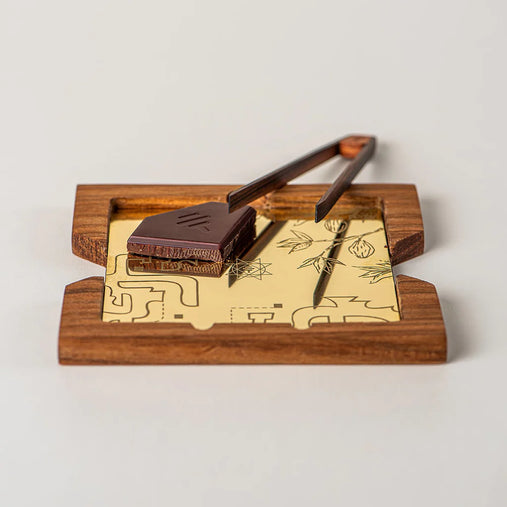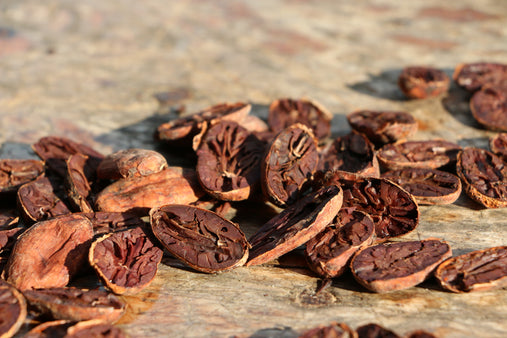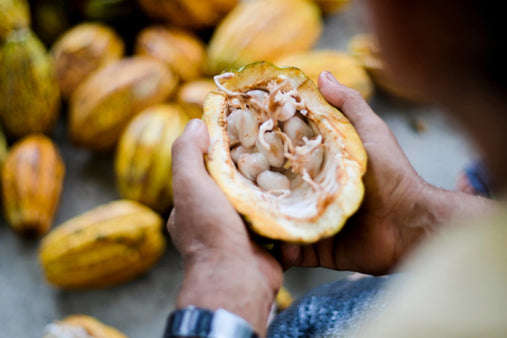
25th of January 2022
More than ever, consumers are demanding transparency from their favorite brands. In response, companies are now inundating us with information to win our trust, with websites and social media posts rich in heartfelt blogs, photos, and stories, and packaging filled with feel-good claims.
Chocolate companies have been especially quick to jump on this bandwagon—to expose the truth about chocolate and prove that theirs is superior. Meanwhile, consumers now expect to see certain terms on their favorite chocolate bars. Organic-certified chocolate? It better be. Vegan chocolate? Of course. Bean-to-Bar? Who isn’t?
In this infinite sea of claims, there are many empty chocolate terms and overused marketing buzzwords that actually don’t mean much at all. These words never equate with quality. Watch for these 11 terms the next time you’re contemplating your next chocolate purchase.
1. Artisan or Handmade Chocolate
For chocolate to be called “artisan” or “handmade,” a master chocolate maker or chocolatier must supervise the production process. Chocolate is made in extremely small quantities, by a handful of employees, using a reduced number of machines in favor of more artisanal methods.
When a chocolate company sells millions of chocolate bars every year and has thousands of stores all over the world, these conditions can’t possibly be respected. These words have become a sneaky way to evoke false feelings of fine-tuned craftsmanship when the reality is large-scale machines, automated processes, and thousands of employees.

2. Bean-to-Bar Chocolate
Not long ago, bean-to-bar used to identify craft chocolate makers that were transforming fine cacao beans into small batches of finished chocolate. Craftsmanship, expertise, and passion were embodied in this term.
Now, industrial chocolate companies have turned “bean-to-bar” into their ultimate buzzword. Sure, big companies also start their process from raw cacao beans (what chocolate doesn’t start from there anyway?!), but the term is far from its deeper original meaning, which put more emphasis on sourcing beans and crafting fine, small-batch chocolate.
3. Natural Ingredients
Marketers use the term “natural” to convey a sense of purity and health, but it really doesn’t mean anything. Government regulations have considered “natural” to mean that nothing artificial or synthetic (like color additives) has been included in, or has been added to, a food that would not normally be expected in that food. The FDA has a vague definition, but anyone can pretty much use the term as it pleases them, while the EU has yet to define it at all.
For now “natural” does not address food production methods, quality of ingredients, or associated health benefits. This claim means nothing more than “we didn’t include what was not meant to be in here in the first place.” In other words, it’s absolutely irrelevant.
4. Country of Cacao Origin
Adding the name of exotic countries like Venezuela, Indonesia, or Ghana on the packaging of a chocolate bar tells us nothing about its quality. In a single cacao producing country there is a huge variation in cacao genetics, terroirs, and post-harvesting methods. Unless further specifications about the source are given (the name of the farm, the cooperative, or at least the geographic area), these locations can’t be associated with quality.

5. Made in (Insert Country)
Would you dare to say that all wine made in Italy is worth the price? Or that all cheese made in France is exquisite? Probably not. Then claiming that all chocolate made in Switzerland, Belgium, or any other country is “the best in the world” is equally as absurd. Regardless of its location, any company can cut costs with cheap raw materials, unethical practices, and a tasteless final product.
Instead of judging a chocolate by where it was made, focus on assessing every chocolate brand individually. Look them up online and find out how transparent their supply chain is, where they get their raw materials from, and if their products’ prices line up with their “fine quality” and “sustainability” claims.
6. Handcrafted Since (Insert Date)
This is an old practice that still persists to this day: Many chocolate companies proudly state the longevity of their business on their packaging as a sign of trustworthiness. But can this truly guarantee quality? A brand that has been around for 200 years could still be making mediocre chocolate candies, while a 2-year-old company can go straight to crafting the best chocolate on the market. Longevity doesn’t inherently equal quality.
7. Direct Trade Chocolate
The term “direct trade” should only be used by companies that do business directly with cacao farmers at origin. But this is a rarity in the chocolate industry. Producers, collectors, and exporters are usually the middlemen, and the majority of chocolate makers simply place an order with them. Sending a purchasing order to a cacao importer is not direct sourcing.
Those who claim to be directly sourcing cacao need to back this claim up with clear proof — and that doesn’t mean simply sharing feel-good imagery of colorful cacao pods and smiley farmers.
8. Sustainable Chocolate
“Sustainable” has become the biggest buzzword in any industry, from fashion to cars to chocolate. This term has no legal criteria nor official definitions that can keep companies accountable for their claims.
To be a sustainable chocolate company, the starting point has to be the price paid for the cacao purchased. If cacao farmers are paid poorly, how is that sustainable? Sustainability in cacao starts with making the lives of cacao farmers sustainable, so they can continue to grow high-quality cacao year after year. This is how the cacao producing cycle stays alive, healthy, and advantageous for everybody involved. The problem is that big chocolate companies are feeding consumers this empty word without any proof to support their “sustainability” claims.
9. Vegan Chocolate
When it comes to milk and white chocolate, the sticker VEGAN is valuable for consumers looking to avoid dairy. A vegan milk or white chocolate will likely be made using alternative milks (or mylks), like almond, oat, coconut, or rice milk. But on dark chocolate? The claim VEGAN only states the obvious. To be legally called dark chocolate, there should be no dairy in the chocolate to begin with. Cacao is naturally vegan — no matter its quality.

10. Gluten-Free
Gluten was also never meant to be in chocolate. Unless the chocolate contains added inclusions with gluten, such as breadcrumbs or cereals, then no necessary ingredient to make chocolate contains gluten. A brand can get a gluten-free certification to reassure its customers that no gluten is processed in the factory. However, if a brand doesn’t have a gluten-free certification, this doesn’t mean that their chocolate contains gluten.
11. Non-GMO and/or Organic
Consumers erroneously believe that, if a chocolate bar doesn’t carry an organic-certified sticker, then it must be full of pesticides, chemicals, and GMOs. That is not true, as GMOs are not part of any stage of the cacao production and most cacao is grown without pesticides.
Organic certifications are very expensive, and therefore only a fraction of chocolate companies can afford them. However, a lot of the cacao traded in the craft chocolate market is organic by default. Moreover, an organic cacao is not always a fine-flavor cacao. Buying only organic chocolate is reductive, and doesn’t always lead to the most flavorful chocolate on the market.
How To Shop Smart
For smart, conscious chocolate shopping, don’t fall for these claims and marketing buzzwords. They’re meant to elicit an emotional response from the consumer, but don’t actually reflect quality. Instead, focus on the chocolate’s specific cacao origin, the reputation of the company, and the flavors you’ll ultimately experience in your mouth.


